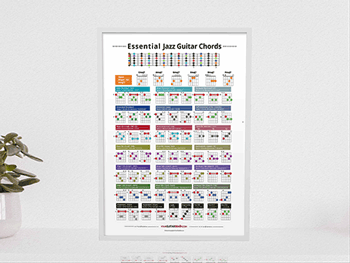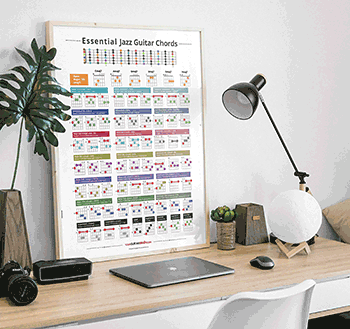All You Need to Know to Play Guitar Chords
The vii Chords Every Guitar Actor Should Know (And Larn Beginning)
Discover what the 7 Essential almost used beginner guitar chords are (+ finger position charts & exercise tips).

This mail shows you how to play the like shooting fish in a barrel basic guitar chords all beginners should learn.
And because mastering open up chord shapes ways you tin can learn how to play your favourite songs, this is one you lot can't afford to miss.
Let's get this show on the road.
The 7 essential nigh used beginner chords ALL guitar players should larn first are E major, E minor, A major, A pocket-size, D major, C major and One thousand major.
With these chords, yous'll be armed with the power to play literally thousands upon thousands of different songs.

NO SHORTCUTS! We believe i f it's worth learning, it'southward worth learning properly. There's no point in wasting your time with 'piece of cake versions' or 'cheat' chords. Learn the correct way. Learn once. Sound epic.
Why these seven Chords are the almost important shapes to acquire first
1. The C-A-1000-E-D-Em-Am open chord shapes can later be changed into stacks of other chord shapes played up the guitar neck. These moveable shapes are known as barre chords.

Fig 1.0 - F major barre chord made from the open up Eastward major chord shape & B minor chord fabricated from the open A small-scale chord shape chord chart
2. Out of the seven chords, the best ii guitar chords to acquire first are E major, E minor. East minor is the outset chord you should learn on the guitar because it is the easiest shape to play by far.

Fig 2.0 - Open East major and E minor chord charts with finger positionand numbers

Fig three.0 - Open A major and A small chord diagramswith finger positionand numbers

Fig 4.0 - Open D major and C major chord chartswith finger positionand numbers

Fig 5.0 - Open Thousand major chord charts with finger placement and numbers

How to read guitar chord charts
The vertical lines in the chord diagram charts represent your guitar strings. The horizontal lines in the chord boxes show the metallic frets.
The string notes are written nether the strings, with the fret number shown on the left of the chart.
The numbers in the circles show what finger y'all should use to fret the string:
1 = 1st (alphabetize) finger
2 = 2d (middle) finger
3 = 3rd (ring) finger
iv = 4th little (pinky) finger
10 = don't play the string
o = open cord
Alarm:E'er use the same finger placements on chords. A mutual beginner and cocky-taught guitar actor mistake is to change chord shape fingerings randomly.
All this does is slow you downwardly and makes edifice upwards muscle memory and fast chord changes a back-breaking task.
How to play guitar chords properly: Top 7 Tips
Notes buzzing or muting on the chords? Follow these top tips to learn how to play chords cleanly, shine, and fast.
#1. Lightly wrap your thumb around the guitar neck
The beginning thing to attempt if your chord changes experience slow and messy is to conform your thumb position. Placing your thumb low downwards at the dorsum of the neck when playing open chords is outdated advice. Information technology makes it difficult to grip and change between the chords easily.
Don't brand difficult piece of work for yourself.
An added bonus to gripping your thumb around the neck is you lot can also mute the depression E string with it on chords that don't use string 6 (A'due south, C's, D's, for example).
#2. Keep your thumb past fret 2
Your thumb acts similar an anchor by helping to control your chord changes and keeping your fingers in the correct position. Your thumb will fight you at outset and desire to move to the left or drop down. Be patient. It takes time to build proper muscle memory.
#three. Press the string with the tips (pad) of your fingers
To get chord notes to ring out conspicuously, pressing down on the string with your fingertip allows you to apply the most amount of pressure level.
Fair warning: your fingers will be very sore at commencement. Expert news? They get tough pretty quickly though when you practice daily.
#4. Bend your fingers
Curving your fingers around will assistance you lot avoid touching the strings below, which stops them from ringing out. Muted and buzzing strings aren't just acquired past pressing downward too lightly; the angle of your fingers, if besides flat, will kill your audio.
#5. Press your finger downwardly with the correct pressure
Many beginner players press downwards too lightly on guitar strings, but a few press as well hard. Follow this unproblematic rule - if your notes ring out clearly, yous're using the right amount of pressure level. If they're non, attempt pressing harder. With practice, you'll find the sweet spot.
#6. Don't place your fingers on the metal frets
Contrary to some advice, you risk the notes muting horribly if you place your fingers also shut to the fret when yous play guitar chord shapes. Position your fingers likewise far back, though, and you'll have to apply fashion more pressure.
Work on finding the sugariness spot, which is midway between the center of the fret box and the metal fret.
#7. Practice chords every time you lot pick your guitar up
Peachy sounding chords and fast changes don't happen overnight. So get practising every day. You demand to develop quality command and standards - never settle for inconsistent sounding chords thinking "I can get away with that".
Never settle for inconsistent sounding chords thinking: "I can become away with that."
Exercises:
- Strum up and downward on individual chords for repeated reps of xxx-60 seconds to build up musculus memory and finger strength. Increase the fourth dimension as your fingers get stronger.
- Do changing between pairs of chords to beginning with. Accept Due east major and E minor every bit your first pair.
- Option through the chords using alternate picking for 30-60 seconds reps. Increment the time as your fingers get more robust. Use a metronome to be working on nonetheless another vital skill.
Become hither to get more chord modify tips and tricks.
Gear up your chord goals:
i. Learn the new chord shapes and memorise the proper noun along with the shape. Knowing chord names means you lot'll learn new songs quicker.
two. Get the chord notes ringing out clearly. They should eventually be mute and fizz-free.
iii. Build up smooth and clean changes between the different chord shapes. Exercise daily and always with a metronome to work on your timing and rhythm.
Essential Jazz Guitar Chords Chart Poster
Featuring 65 of the most used mutual jazz (dejection, funk and country too) chord shape voicings & extensions + bonus Guitar Fretboard Notes Nautical chart
Downloadable music prints that make your time learning guitar easier...
Jazz Guitar chord shapes include:
- Major seventh (Maj 7th)
- Minor Seventh
- Diminished - One-half Macerated
- Ascendant seventh
- Major 9th / small-scale ninth / dom 9th
- Maj11th / small-scale 11th / dom 11th
- Maj13th / minor 13th / dom 13th
and more...


Source: https://yourguitarbrain.com/7-beginner-chords-every-guitar-player-should-know/
0 Response to "All You Need to Know to Play Guitar Chords"
Post a Comment